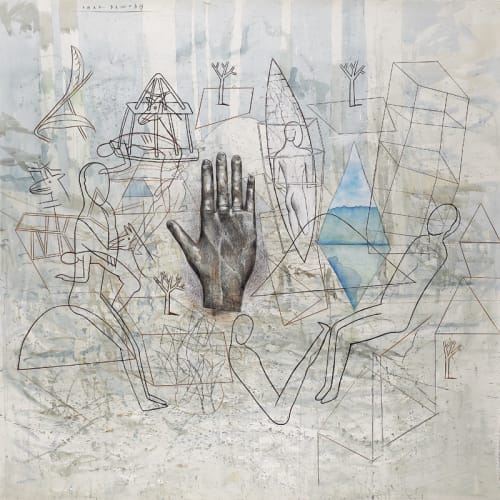Meem Gallery presents Amar Dawod's first solo exhibition in Dubai, displaying twenty-six mixed-media works by the artist. The exhibition is dedicated to the mystical writings of Mansur al-Hallaj, the famous Sufi thinker, writer and teacher who was executed in 922 for heresy. Drawing specifically on al-Hallaj's celebrated Kitab al-Tawasin (The Tawasin) as a point of departure for this series, Dawod represents his understanding of the eleven verses of The Tawasin in vivid and muted colours. His compositions demonstrate the careful interaction between line, abstract form, attention to detail and collage in his rendering of figures, angels, and patterned patchwork backgrounds. The exhibition's catalogue will feature essays by the artist, Stephen Hirtenstein, Louai Hamza Abbas, and Suhail Sami Nader, as well as a full English translation of The Tawasin.
Dawod has drawn influence from the works of al-Hallaj since his early years in Baghdad, during the mid-1970s. At the Institute of Fine Arts, where the artist received his diploma in 1979, Dawod attended the lectures of the late artist Shakir Hassan Al Said, whose theoretical ideas on art were strongly derived from Sufi thought (most notably his theory of the One Dimension). For Dawod, the ideas of al-Hallaj resonate 'because of the inherent desire of painters to traverse the self and overcome or deny it in order to completely ascend to where God declares His presence through the signs that have influenced many of the Sufis' minds, including al-Hallaj.' Though Dawod's works are not a literal translation of al-Hallaj's ideas, he has noted that the Sufi thinker's often complex style of writing has affected the approach to his art practice: 'This unique style has inspired my artistic perspective and its approaches, thus enabling me to rebel against the method and conditions of what is called "pure painting", in addition to enhancing my ability to focus on my individual style and artistic practice. Today's art should, therefore, open new horizons for interpreting its formal and connotative spheres which are expanding all the time.'

